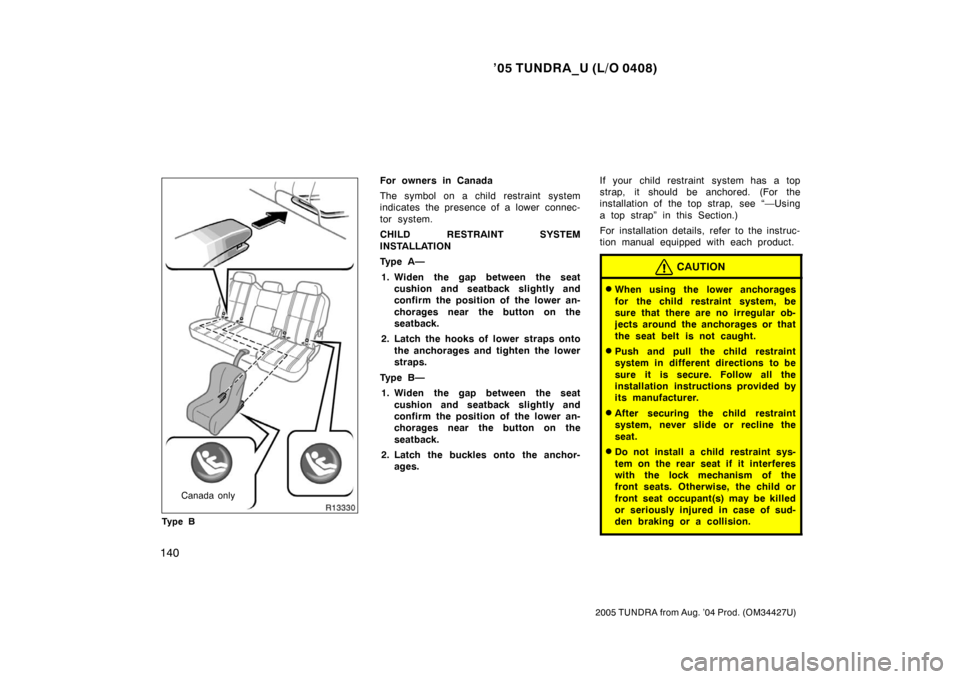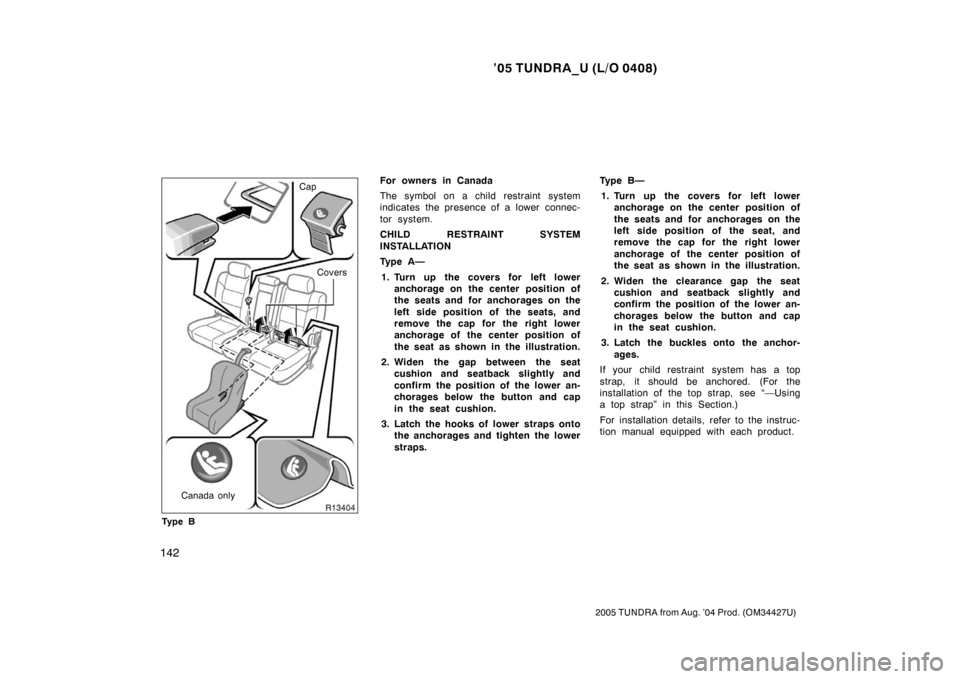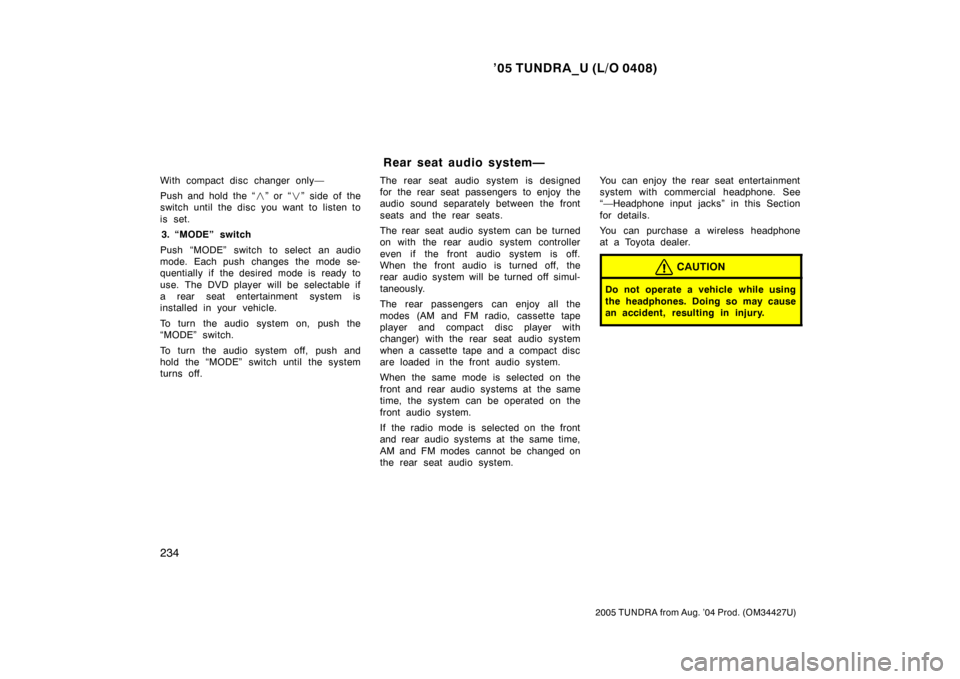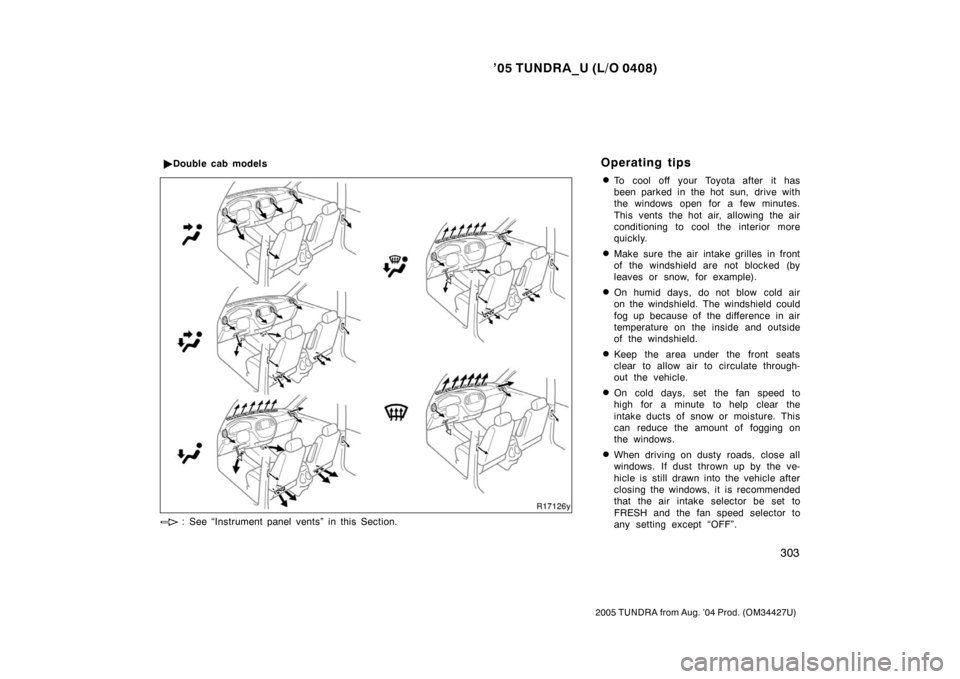Page 147 of 506
’05 TUNDRA_U (L/O 0408)
136
2005 TUNDRA from Aug. ’04 Prod. (OM34427U)
Anchor brackets
Use one anchor bracket on the back of
rear seats and two anchor brackets on the
floor as shown above to attach the top
strap.
Anchor brackets are installed for each
rear seating position.TO USE THE ANCHORAGES:
1. Remove the head restraint.Outside position
Center position
Page 151 of 506

’05 TUNDRA_U (L/O 0408)
140
2005 TUNDRA from Aug. ’04 Prod. (OM34427U)
Canada only
Ty p e B
For owners in Canada
The symbol on a child restraint system
indicates the presence of a lower connec-
tor system.
CHILD RESTRAINT SYSTEM
INSTALLATION
Ty p e A — 1. Widen the gap between the seat cushion and seatback slightly and
confirm the position of the lower an-
chorages near the button on the
seatback.
2. Latch the hooks of lower straps onto the anchorages and tighten the lower
straps.
Ty p e B — 1. Widen the gap between the seat cushion and seatback slightly and
confirm the position of the lower an-
chorages near the button on the
seatback.
2. Latch the buckles onto the anchor- ages. If your child restraint system has a top
strap, it should be anchored. (For the
installation of the top strap, see “—Using
a top strap” in this Section.)
For installation details, refer to the instruc-
tion manual equipped with each product.
CAUTION
�When using the lower anchorages
for the child restraint system, be
sure that there are no irregular ob-
jects around the anchorages or that
the seat belt is not caught.
�Push and pull the child restraint
system in different directions to be
sure it is secure. Follow all the
installation instructions provided by
its manufacturer.
�After securing the child restraint
system, never slide or recline the
seat.
�Do not install a child restraint sys-
tem on the rear seat if it interferes
with the lock mechanism of the
front seats. Otherwise, the child or
front seat occupant(s) may be killed
or seriously injured in case of sud-
den braking or a collision.
Page 152 of 506
’05 TUNDRA_U (L/O 0408)
141
2005 TUNDRA from Aug. ’04 Prod. (OM34427U)
Center
Left
Lower anchorages for the child restraint
systems complying with the FMVSS225
or CMVSS210.2 specifications are
installed in the center and left positions
of the rear seats.
The anchorages are installed in the gap
between the seat cushion and seatback
for center and left positions of rear seats.
Child restraint systems complying with the
FMVSS213 or CMVSS213 specification
can be fixed to these anchorages. In this
case, it is not necessary to fix the child
restraint system with a seat belt on the
vehicle.Cap
Covers
Canada only
Ty p e A
—Installation with child
restraint lower anchorages
(double cab models)
Page 153 of 506

’05 TUNDRA_U (L/O 0408)
142
2005 TUNDRA from Aug. ’04 Prod. (OM34427U)
Cap
Covers
Canada only
Ty p e BFor owners in Canada
The symbol on a child restraint system
indicates the presence of a lower connec-
tor system.
CHILD RESTRAINT SYSTEM
INSTALLATION
Ty p e A — 1. Turn up the covers for left lower anchorage on the center position of
the seats and for anchorages on the
left side position of the seats, and
remove the cap for the right lower
anchorage of the center position of
the seat as shown in the illustration.
2. Widen the gap between the seat cushion and seatback slightly and
confirm the position of the lower an-
chorages below the button and cap
in the seat cushion.
3. Latch the hooks of lower straps onto the anchorages and tighten the lower
straps. Ty p e B —
1. Turn up the covers for left lower anchorage on the center position of
the seats and for anchorages on the
left side position of the seat, and
remove the cap for the right lower
anchorage of the center position of
the seat as shown in the illustration.
2. Widen the clearance gap the seat cushion and seatback slightly and
confirm the position of the lower an-
chorages below the button and cap
in the seat cushion.
3. Latch the buckles onto the anchor- ages.
If your child restraint system has a top
strap, it should be anchored. (For the
installation of the top strap, see “—Using
a top strap” in this Section.)
For installation details, refer to the instruc-
tion manual equipped with each product.
Page 154 of 506
’05 TUNDRA_U (L/O 0408)
143
2005 TUNDRA from Aug. ’04 Prod. (OM34427U)
CAUTION
�When using the lower anchorages
for the child restraint system, be
sure that there are no irregular ob-
jects around the anchorages or that
the seat belt is not caught.
�Push and pull the child restraint
system in different directions to be
sure it is secure. Follow all the
installation instructions provided by
its manufacturer.
�After securing the child restraint
system, never recline the seat.
�Do not install a child restraint sys-
tem on the rear seat if it interferes
with the lock mechanism of the
front seats. Otherwise, the child or
front seat occupant(s) may be killed
or seriously injured in case of sud-
den braking or a collision.
Page 245 of 506

’05 TUNDRA_U (L/O 0408)
234
2005 TUNDRA from Aug. ’04 Prod. (OM34427U)
With compact disc changer only—
Push and hold the “� ” or “�” side of the
switch until the disc you want to listen to
is set.
3. “MODE” switch
Push “MODE” switch to select an audio
mode. Each push changes the mode se-
quentially if the desired mode is ready to
use. The DVD player will be selectable if
a rear seat entertainment system is
installed in your vehicle.
To turn the audio system on, push the
“MODE” switch.
To turn the audio system off, push and
hold the “MODE” switch until the system
turns off. The rear seat audio system is designed
for the rear seat passengers to enjoy the
audio sound separately between the front
seats and the rear seats.
The rear seat audio system can be turned
on with the rear audio system controller
even if the front audio system is off.
When the front audio is turned off, the
rear audio system will be turned off simul-
taneously.
The rear passengers can enjoy all the
modes (AM and FM radio, cassette tape
player and compact disc player with
changer) with the rear seat audio system
when a cassette tape and a compact disc
are loaded in the front audio system.
When the same mode is selected on the
front and rear audio systems at the same
time, the system can be operated on the
front audio system.
If the radio mode is selected on the front
and rear audio systems at the same time,
AM and FM modes cannot be changed on
the rear seat audio system.You can enjoy the rear seat entertainment
system with commercial h
eadphone. See
“—Headphone input ja cks” in this Section
for details.
You can purchase a wireless headphone
at a Toyota dealer.
CAUTION
Do not operate a vehicle while using
the headphones. Doing so may cause
an accident, resulting in injury.
Rear seat audio system—
Page 314 of 506

’05 TUNDRA_U (L/O 0408)
303
2005 TUNDRA from Aug. ’04 Prod. (OM34427U)
�To cool off your Toyota after it has
been parked in the hot sun, drive with
the windows open for a few minutes.
This vents the hot air, allowing the air
conditioning to cool the interior more
quickly.
�Make sure the air intake grilles in front
of the windshield are not blocked (by
leaves or snow, for example).
�On humid days, do not blow cold air
on the windshield. The windshield could
fog up because of the difference in air
temperature on the inside and outside
of the windshield.
�Keep the area under the front seats
clear to allow air to circulate through-
out the vehicle.
�On cold days, set the fan speed to
high for a minute to help clear the
intake ducts of snow or moisture. This
can reduce the amount of fogging on
the windows.
�When driving on dusty roads, close all
windows. If dust thrown up by the ve-
hicle is still drawn into the vehicle after
closing the windows, it is recommended
that the air intake selector be set to
FRESH and the fan speed selector to
any setting except “OFF”.
�
Double cab models
: See “Instrument panel vents” in this Section.
Operating tips
Page 374 of 506

’05 TUNDRA_U (L/O 0408)
363
2005 TUNDRA from Aug. ’04 Prod. (OM34427U)
Ti r e relat ed ter mMeaning
Accessory weight
the combined weight (in excess of those standard items which may be
replaced) of automatic transmission, power steering, power brakes, power
windows, power seats, radio, and heater, to the extent that these items
are available as factory −installed equipment (whether installed or not)
Cold tire inflation pressure
tire inflation pressure when the vehicle has been parked for at least 3
hours or more, or it has not been driven more than 1.5 km or 1 mile
under that condition
Curb weight
the weight of a motor vehicle wi th standard equipment including the
maximum capacity of fuel, oil, and coolant, and, if so equipped, air
conditioning and additional weight optional engine
Intended outboard sidewall
(A) the sidewall that contains a whitewall, bears white lettering or bears manufacturer, brand, and/or model name molding that is higher or
deeper than the same molding on th e other sidewall of the tire, or
(B) the outward facing sidewall of an asymmetrical tire that has a particular side that must always face outward when mounted on a vehicle
Maximum inflation pressurethe maximum cold inflation pressure to which a tire may be inflated and it
is shown on the sidewall of the tire
Maximum loaded vehicle weight
t he sum of —
(a) curb weight;
(b) accessory weight;
(c) vehicle capacity weight; and
(d) production options weight
—Glossary of tire terminology